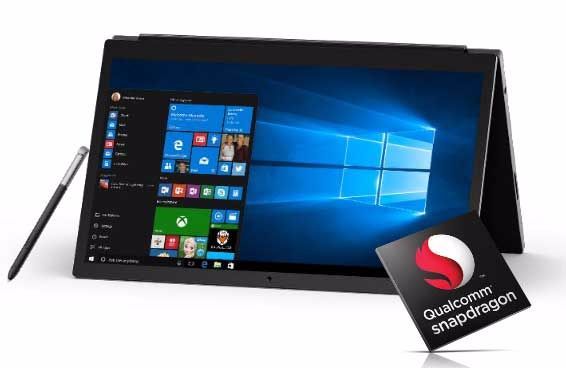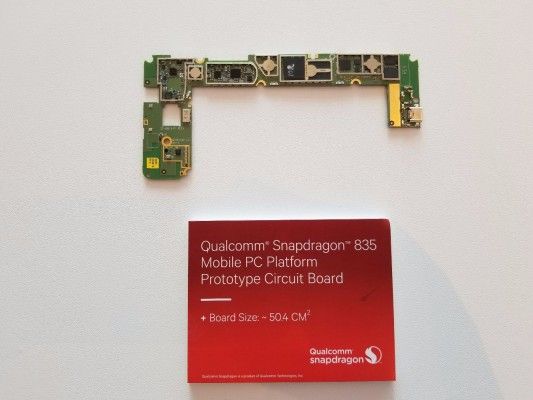Inside Microsoft's Plan to Change Laptops Forever
The future of laptops is pointing towards one that's always-on with data over 4G (and eventually 5G). It's been the key message behind several high-profile announcements from Intel and Qualcomm and Microsoft over the past several weeks.

Following an announcement at Computex in Taiwan earlier this month, Laptop Mag sat down with Pete Bernard, principal group program manager at Microsoft, to talk about Microsoft and Qualcomm's plans for a future with connected laptops using Snapdragon mobile processors. Yes, those are the same CPUs you'll find in handsets such as the Samsung Galaxy S8.
"There's a lot of folks in a lot of markets that are mobile-first," Bernard said. "In fact, for a lot of folks, the ability to be connected and mobility are kind of their oxygen.” Windows, however, is not exactly mobile-first. There are some business laptops with support for SIM cards, but most people rely on Wi-Fi. And when you're on the go, you may not have access to a hotspot.
So Microsoft set out to offer that kind of always-on connectivity and make laptops act more like phones in two other ways: turning on instantly, and having long battery life, Bernard said. “That drove us to a bunch of engineering investments," Bernard said of the quest to make laptops more like handsets, "one of which is working with Qualcomm, but also with Intel on figuring out what we need to do with Windows and the ecosystem to pull this together.”
Connected standby
Connected standby means that if your machine goes into a low-power state — perhaps you put it to "sleep" in your bag — it can continue running operations, syncing email and streaming data when you aren't actively using it. "The nice thing about the Snapdragon stuff is that they go into a very, very deep sleep and can still do the connectivity stuff in the background," Bernard said.
“So you'll see PCs doing 30 days of standby or some crazy numbers with Qualcomm." And developers won't have to do anything extra to take advantage of this capability. Due to x86 emulation technologies, apps should run on Snapdragon without experiencing any problems, Bernard said, adding that Windows 10 behaves the same way on both ARM and x86 architecture, so you won’t notice a huge difference whether use an Intel or Qualcomm chip. "We encourage you to write universal apps because that means it will scale across form factors, it will be in the store, it will be automatically compiled for ARM," he said. "[But] if you wrote an x86 app 10 years ago, and it's out there, you don't have to take any action.”
In a recent blog post celebrating 50 years of its x86 architecture, Intel threw some shade at the Microsoft-Qualcomm partnership, implying that it might violate Intel's patents. "However, there have been reports that some companies may try to emulate Intel's proprietary x86 ISA [Instruction Set Architecture] without Intel's authorization," Steven Rodgers, executive vice president and general counsel for Intel, wrote in the June 8 blog post. He mentioned Transmeta, a company that exited the microprocessor business after Intel used its patents against the company, which was emulating x86.
Stay in the know with Laptop Mag
Get our in-depth reviews, helpful tips, great deals, and the biggest news stories delivered to your inbox.
"Only time will tell if new attempts to emulate Intel's x86 ISA will meet a different fate,". Rodgers wrote. "However, we do not welcome unlawful infringement of our patents, and we fully expect other companies to continue to respect Intel's intellectual property rights.” That didn’t seem to deter Qualcomm:
"Given our recent announcement with ASUS, HP and Lenovo, we found the blog that one of our competitors published on June 8 very interesting," a Qualcomm spokesperson told Laptop Mag. "We look forward to the launch of the always connected Windows 10 PC powered by the Qualcomm Snapdragon 835 Mobile PC Platform later this year. As showcased at Computex 2017 in conjunction with Microsoft, the Snapdragon 835 Mobile PC Platform brings a true always-connected PC experience with support for up to Gigabit LTE connectivity and all-day battery life for sleek, thin and fanless designs. This will change the future of personal computing.”

Rise of the eSIM
You probably have at least one device with a SIM card: your smartphone. Would you know how to get another SIM card for your laptop? Would you even bother? At a news conference at Computex, Microsoft announced partnerships with a number of wireless carriers, including AT&T and T-Mobile in the U.S. The idea behind the partnerships is that you add your account information in the Windows Store, and it's applied to a built-in SIM card that you never touch.
"So, for people that are buying things on the web, buying things at open-market electronic stores, you can now get it activated and connected without any hassle," Bernard said. "So that's really the big win." The built-in SIM card also makes it easier to travel with your device, he pointed out. Perhaps you want to buy just 1GB of data for a week abroad. Just type it in, reprogram the eSIM and switch back to your home profile when you return.
Right now, it can cost an extra $50 to $100 to add a SIM card slot to a business laptop, and many companies, such as Dell and Lenovo, charge much more than that. On Qualcomm's Snapdragon PCs, Bernard said, the module is built into the chip design in an effort to drive down costs.
"And, in fact, what's neat about all the Snapdragon-based PCs is, there's no Wi-Fi-only version of that PC; it's just always connected," Bernard said. "So I hope that, when people experience always being connected, they won't go back to Wi-Fi-only."
Unlimited potential?
If you're like me, you have a limited monthly data plan, and many of us go over that data limit more than we'd like to admit. But many people are starting to sign up for new larger and unlimited data plans, and that switch may be necessary for a truly mobile laptop. Bernard said that thanks to unlimited data plans and smarter data usage on the PC, , networks will be able to handle the additional traffic. And if people are used to using more data with many devices, your new laptop with LTE will be “just another device on the network,” he added.
For now, though, we're still waiting on the specifics about these devices. We know that Qualcomm is working with Asus, HP and Lenovo, and that Intel has a partnership with Asus for a 2-in-1 called Project Kakuna. What we don't know, however, are dates or prices, so it may be a while before we get to try these always-connected laptops for ourselves.
Images credits: Qualcomm
Andrew is a contributing writer at Laptop Mag. His main focus lies in helpful how-to guides and laptop reviews, including Asus, Microsoft Surface, Samsung Chromebook, and Dell. He has also dabbled in peripherals, including webcams and docking stations. His work has also appeared in Tom's Hardware, Tom's Guide, PCMag, Kotaku, and Complex. He fondly remembers his first computer: a Gateway that still lives in a spare room in his parents' home, albeit without an internet connection. When he’s not writing about tech, you can find him playing video games, checking social media and waiting for the next Marvel movie.
